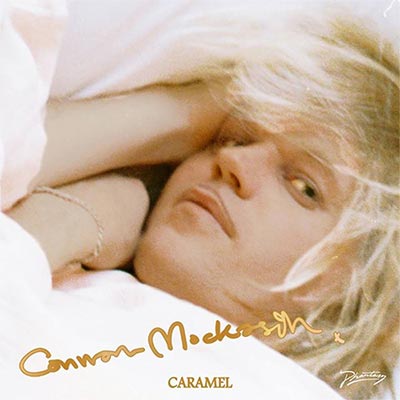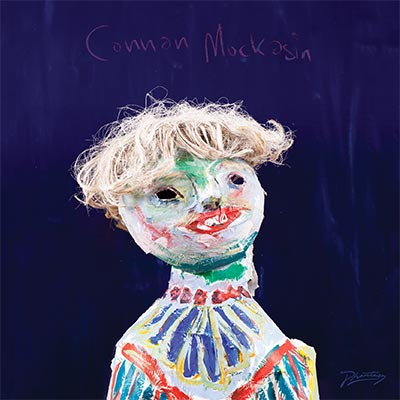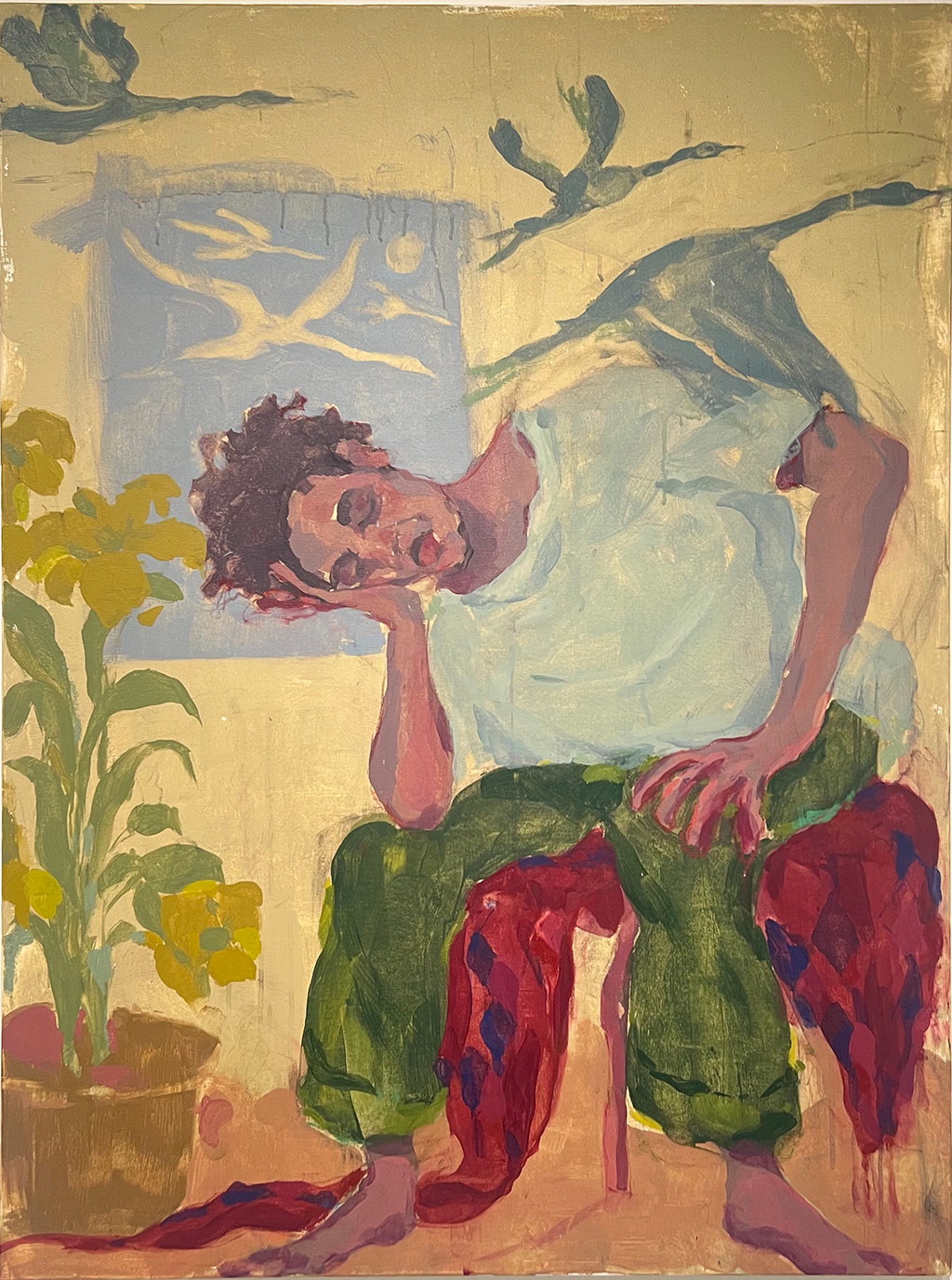
With his latest 2013 full-length, Caramel, Connan Mockasin’s music has taken in soulful influences to become a fair degree more grounded and accessible — but it seems that he still has trouble shaking the character judgments heaped upon him. Caramel is conventional compared to Forever Dolphin Love, but it remains fairly unconventional in the world of indie soul and R&B, full of moments that might be difficult to relate to from outside perspectives.
But talk to Connan Mockasin for any length of time, and one learns very quickly that his motivations and attitudes towards music-making — and life, in general — are actually much, much simpler than most would predict. The bulk of his decisions are based upon impulses rather than deep considerations, and flowing from moment to moment without preconceived expectations or concerns for consequence is his general mode of operation. Indeed, it is one that very few people can relate to — which is perhaps why it is so very “odd” — but to understand this is to understand the essence of Connan Mockasin’s creative genius.
One can unearth plenty of examples, even dating as far back as the moniker Connan Mockasin. Though it reads almost like a birth-given name, his real name is in fact Connan Tant Hosford, and the Mockasin moniker grew out of his teenage hobby of designing moccasins made of sheepskin and motorbike tires. It is an unconventional hobby, to be sure — and one of many that Hosford has had in his life, including a love of building carnival rides — but these interests serve to illustrate the kind of fly-by-the-seat-of-his-pants “doer” he is. Hosford simply follows his whims, as they dictate his interests.
Take, for instance, the album title, Caramel. Though most musicians deliberate over album titles well after the music-making process itself has been completed, Hosford named the album before ever recording a single sound — and possibly before even considering any at all. He simply liked the word.
 “I thought I would just make what I thought a record called caramel would sound like,” Hosford explains with utmost ease. “I’m not really even into sweet food or anything… I just like the name; there wasn’t too much thought.”
“I thought I would just make what I thought a record called caramel would sound like,” Hosford explains with utmost ease. “I’m not really even into sweet food or anything… I just like the name; there wasn’t too much thought.”
In early press releases about the record, Hosford describes Caramel, saying, “It starts with the dolphin [from Forever Dolphin Love] leaving, and the boss (the man) who is so in with love with the dolphin is sad, and then it kicks into the new album, and he is happier. But there’s a car race and a crash…”
This on-paper description of Caramel seems extremely conceptual — and the record’s theatrical samples seem to play into the larger concept easily — but in reality, Caramel actually isn’t that conceptual at all. And it’s not really meticulous either, despite how intricate it may seem. The narrative of dolphin and boss is extremely loose — so much so, in fact, that Hosford has very little to say when questioned about it.
 “That was just, basically, finishing off the last record, and the dolphin having to disappear and go back to the sea, and then introducing him again in the new record,” he cryptically details.
“That was just, basically, finishing off the last record, and the dolphin having to disappear and go back to the sea, and then introducing him again in the new record,” he cryptically details.
What then, about the sampled and seemingly intentionally-planned sound bites, such as that of a girl crying with an almost sexual intensity, a guitar rigged to mimic the aforementioned car crash, and a chorus of Japanese girls chanting “Connan Mockasin”? While each of these moments are accompanied by a fascinating story, Hosford insists that they are merely the result of happenstance and the late-night hotel sleepovers that provided the backdrop for Caramel. They do not at all tie in with any overarching tale about dolphins and bosses, even if that would add a fantastically exciting element.
“[We] were at a hotel in Tokyo, and one of the Japanese girls started talking about car racing and then crashing, and so, I made a car crash with a guitar. Not too much thought; it just seemed like the right thing at the time,” Hosford says, stressing that he’s not entirely sure how the elements ended up being used in the first place. “And the crying was… this girl who started fake crying but ended up real crying by the end of it. We were a bit drunk, so I don’t know.”
It seems that nothing is cut-and-dry when it comes to the decision-making of Connan Mockasin, and even the fact that Hosford was in Tokyo for the creation of Caramel was circumstancial. He returned to his home country of New Zealand for months because his father nearly died, and the halfway points between New Zealand and his current home in the United Kingdom are Tokyo and Los Angeles. Tokyo was the perfect fit, as Hosford has long been fascinated by Japanese culture and views the city as a “sexy place” that is “quite mysterious” — both descriptions that seem to fit well into the off-kilter sensuality of Caramel. It seems that there would be hardly anywhere else where writing and recording the record would have been more suitable.
Connan Mockasin – “I’m The Man, That Will Find You” Live Performance
When one takes a look at how Hosford operates, both as Connan Mockasin and in his personal life, it seems absolutely incredible that the outcomes of his actions might bear so much fruit. Yet the saying, “First thought, best thought,” is something that resonates intensely with him — and it can be seen exercised in his approach to life as well as throughout his creative process, to an impressive degree.
His methods for writing and recording serve as prime examples of this. With the exception of extremely minor tweaks, or in the discovery of mistakes that yield pleasant surprises, almost everything Hosford puts down during his first run-through is already the final product. Both due to the way his mind works and because home recording is too time-intensive a process to allow for the superfluous, creating music and later scrapping it is absolutely not his style.
“I usually scrap it in my head — like, I play around with it in my head or hear it out a bit,” Hosford explains. “[But] I usually have a pretty good idea of how it should be when I put it down.”
“Usually I don’t sit down and write songs,” he continues. “I just hear music in my head, I guess. And if I can be bothered — if I’m not too lazy to make a record, as I’ve only done two records now; I haven’t done that much — I just like going with the first thing, trying to get the first idea in your head and getting it down as quick as possible. The way it comes out is usually the most mysterious, and even if it sounds like a bad track at first, it’s better than refining it too much.”
It is when Hosford speaks of creating music that clarity and mastery shines through the most. In that domain, he very much knows why he creates the way he does; in other domains, he seems less readily in a position to explain away his actions.
“That’s the tricky thing. I find it really hard doing interviews,” he says, in response to why journalists might find his motivations hard to relate to. “Now, I’m starting to feel like I’m in a shrink situation. Like, ‘Why did I do that?’… it’s pretty hard, because you’re not really thinking about why… it just seems like a good idea at the time.”
“But I think that’s the same with everything; it’s all kind of the same sort of stuff, isn’t it?” Hosford then questions, pulling life itself into the whole equation. It may be the most profound and most telling thing he says during the whole conversation, and he asks it rhetorically with a natural ease that proves that he not only believes the sentiment, but lives it fully.
Indeed, despite all of the assumptions that Connan Mockasin may conjur in the minds of journalists and fans, everything that he does really boils down to simple building blocks. He does because he needs to and feels an impulse to, regardless of what surprises “doing” may bring. And tied in with this mentality is a true sense of humility that exudes from his being; every bit of success he sees seems like an earth-tremoring shock in his universe, probably because it actually was completely unexpected. Connan Mockasin is indeed not your standard musician or even human being — and on this note, maybe he is “odd”. It just isn’t in the way that you might think.
Ω
Connan Mockasin Music Video Gallery
For those who are visually-inclined, Connan Mockasin’s music might feel like rich fodder for painting vibrant, multi-dimensional worlds of texture, color, and feeling. In fact, Hosford’s sonic landscapes can be so evocative for those who pick up on these cues that it might be easy to believe that Hosford himself creates music with a fully-formed vision of the world his music might reside in. One would be wrong in this assumption, however. Connan Mockasin has many music videos in his repetoire, but almost all of them are spearheaded by his more visually-inclined friends — the result of artistic exchanges of mutual respect rather than Hosford’s singular vision. Luckily for Hosford, these collaborators pick up on the potential of his work, to cohesively flesh out fully-formed visual worlds.
Connan Mockasin — “I’m The Man, That Will Find You” Music Video
Connan Mockasin’s latest music video, for “I’m The Man, That Will Find You”, is directed by Daniel Brereton and set in a dimly lit mansion full of classically romantic things like hot tubs and pianos. Throughout it, Hosford playfully acts his most honest yet tongue-in-cheek role yet, teaching viewers how to seduce women through long glances and suave (or not so suave) moves galore. It’s a polarizing creation — charming for those who understand Hosford’s sense of humor and “creepy” for those who don’t — but the video feels like an extension of the philosophies governing the Caramel record itself. It captures the maximum essence of all that could possibly be caramel smooth sexiness, albeit in a non-serious manner.
Connan Mockasin — Forever Dolphin Love Music Videos
When one looks at Connan Mockasin’s back catalog, this same strength of sonic and visual coherence can be found. Forever Dolphin Love comes with a slew of particularly great examples which capture Connan Mockasin’s sonic world with an unbelievable amount of feeling and visual accuracy. The music video for the playful title track, also directed by Daniel Brereton, shows Hosford amongst a crew of mismatched friends, facially-painted in the childish manner that matches the self-portrait used on the album cover, as cameras back and forth to the rhythm of the track’s infectious bassline. The nonsensical “It’s Choade, My Dear”, directed by Sam Handley, has Hosford acting as a “Rat Emperor” and looking just as nonsensically in bright-colored natural surroundings; the sonic weightlessness of “Faking Jazz Together”, directed by Fleur&Manu, is mirrored in a dreamy pagan ritual where a number of characters float and dangle in mid-air. Hosford takes little credit for any of this.
“I wasn’t really thinking about making a world for [Forever Dolphin Love]. So it’s really great that some people get that from it,” Hosford explains, with regards to both his director friends and his fans. “It’s really nice. It’s really cool. They’ve got a better imagination than I do, which is great.”







[…] Vivian Hua: Redivine Magazine. http://www.redefinemag.com/2014/connan-mockasin-band-interview-caramel-dreams-oddball/ […]